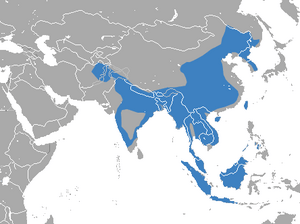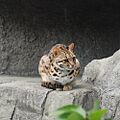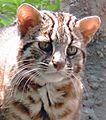Leopard cat facts for kids
Quick facts for kids Leopard cat |
|
|---|---|
 |
|
| Conservation status | |
| Scientific classification | |
| Kingdom: | |
| Phylum: | |
| Class: | |
| Order: | |
| Family: | |
| Genus: | |
| Binomial name | |
| Prionailurus bengalensis |
|
 |
|
| Leopard cat range | |
The leopard cat (Prionailurus bengalensis) is a small wild cat found across South Asia and East Asia. Since 2002, experts have listed it as a species of Least Concern. This means it is not currently in danger of disappearing. These cats are found in many places. However, their homes are sometimes lost, and they can be hunted. There are twelve different types, or subspecies, of leopard cats. They look quite different from each other. Even though it's called a leopard cat, it's not closely related to the leopard. It got its name because of its spots, which look like a leopard's.
Contents
Where Leopard Cats Live
Leopard cats are the most widespread small cats in Asia. You can find them from the Russian Far East all the way to Korea, China, Indochina, the Indian subcontinent, northern Pakistan, the Philippines, and the Sunda Islands in Indonesia.
They usually prefer to live in forests. But they can also be found in areas where people farm. They live in warm, wet evergreen rainforests and plantations near the sea. They also live in cooler deciduous and conifer forests in the Himalayas. Some have been seen as high as 4,500 meters (14,760 feet) up in the Kanchenjunga Conservation Area.
In the colder northern parts of their range, they live near rivers and in ravine forests. They try to avoid places with more than 10 centimeters (4 inches) of snow. They are rare in the dry, treeless areas of Pakistan. In Afghanistan, they were seen in the 1970s in the Kunar Valley and Dare Pech forest.
Leopard Cat Behavior
Leopard cats usually live alone, except when they are ready to have babies. Some hunt during the day, but most prefer to hunt at night. They like to sneak up on small animals like mice, rats, tree shrews, and hares.
They are very good at climbing trees and spend a lot of time there. They rest in trees, but also hide in thick, thorny bushes on the ground. In oil palm plantations, they have been seen climbing up to 4 meters (13 feet) high. There, they hunt rodents and beetles. Male leopard cats usually have larger home areas than females. A male's area might be about 3.5 square kilometers (1.4 square miles). A female's area is about 2.1 square kilometers (0.8 square miles). One male's area can overlap with several female areas.
Leopard cats can swim, but they don't do it very often. They make sounds similar to a pet cat. Both male and female leopard cats mark their territory. They do this by spraying urine, leaving their waste in open spots, rubbing their heads, and scratching.
What Leopard Cats Eat
Leopard cats are carnivores, which means they eat meat. They hunt a variety of small animals. This includes mammals, lizards, amphibians, birds, and insects. In most places, small rodents like rats and mice are their main food. They also eat grass, eggs, poultry, and animals from the water.
They are active hunters. They catch their prey with a quick jump and bite. Unlike many other small cats, they don't "play" with their food. They hold on tightly with their claws until the animal is dead. This might be because they eat a lot of birds. Birds are more likely to fly away if they are let go than rodents are.
Reproduction and Life Cycle
The time when leopard cats have babies depends on the weather. In warm places, kittens can be born all year round. In colder places further north, females usually give birth in the spring.
Their gestation period, which is how long they are pregnant, lasts about 60 to 70 days. A mother usually has two or three kittens in a litter. Kittens born in zoos weighed about 75 to 130 grams (2.6 to 4.6 ounces) at birth. They opened their eyes by 15 days old at the latest. Within two weeks, their weight doubled. By five weeks old, they were four times their birth weight.
When they are about four weeks old, their adult canine teeth start to grow. This is when they begin to eat meat. Female leopard cats in zoos can have their first litter when they are about 13 to 14 months old. Leopard cats in zoos have lived for up to thirteen years.
Related pages
Images for kids
-
A leopard cat in the Sundarbans, India
-
A leopard cat at the Bronx Zoo
See also
 In Spanish: Gato de Bengala para niños
In Spanish: Gato de Bengala para niños









